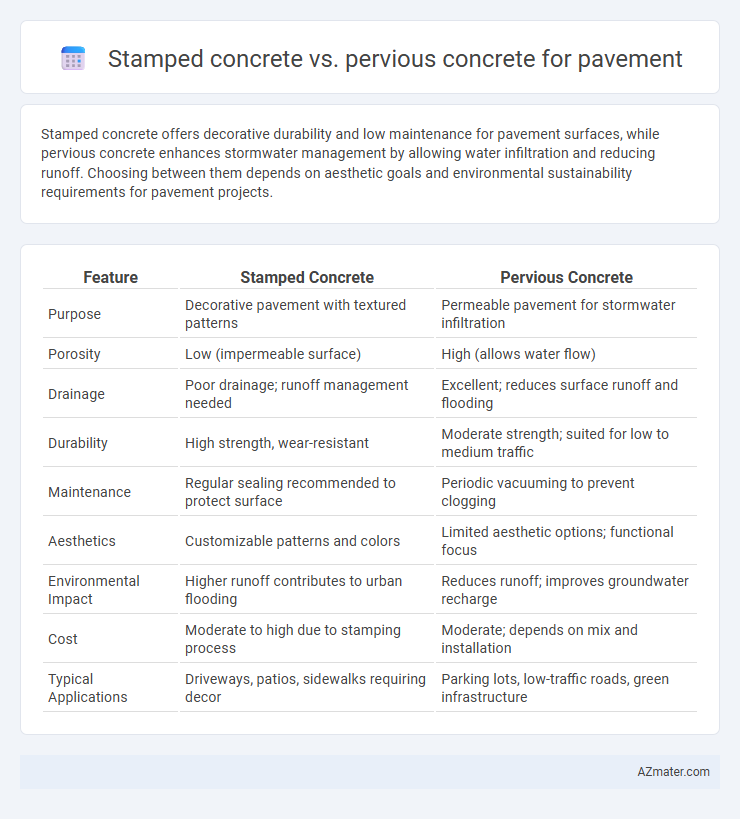Stamped concrete offers decorative durability and low maintenance for pavement surfaces, while pervious concrete enhances stormwater management by allowing water infiltration and reducing runoff. Choosing between them depends on aesthetic goals and environmental sustainability requirements for pavement projects.
Table of Comparison
| Feature | Stamped Concrete | Pervious Concrete |
|---|---|---|
| Purpose | Decorative pavement with textured patterns | Permeable pavement for stormwater infiltration |
| Porosity | Low (impermeable surface) | High (allows water flow) |
| Drainage | Poor drainage; runoff management needed | Excellent; reduces surface runoff and flooding |
| Durability | High strength, wear-resistant | Moderate strength; suited for low to medium traffic |
| Maintenance | Regular sealing recommended to protect surface | Periodic vacuuming to prevent clogging |
| Aesthetics | Customizable patterns and colors | Limited aesthetic options; functional focus |
| Environmental Impact | Higher runoff contributes to urban flooding | Reduces runoff; improves groundwater recharge |
| Cost | Moderate to high due to stamping process | Moderate; depends on mix and installation |
| Typical Applications | Driveways, patios, sidewalks requiring decor | Parking lots, low-traffic roads, green infrastructure |
Introduction to Stamped and Pervious Concrete
Stamped concrete mimics the appearance of natural stone, brick, or wood through patterned impressions, providing both aesthetic appeal and durability for pavements. Pervious concrete features a porous structure that allows water to pass through, reducing runoff and improving stormwater management on paved surfaces. Both materials serve distinct functional and environmental roles, making them suitable for different pavement applications.
What is Stamped Concrete?
Stamped concrete is a decorative pavement option where patterns and textures are imprinted onto freshly poured concrete to mimic materials like brick, stone, or wood, enhancing aesthetic appeal. It offers high durability and low maintenance, making it suitable for driveways, patios, and walkways requiring both functionality and design versatility. Compared to pervious concrete, stamped concrete prioritizes visual appeal and surface customization over water permeability.
What is Pervious Concrete?
Pervious concrete is a specialized pavement material designed to allow water to pass through its porous structure, reducing surface runoff and promoting groundwater recharge. Unlike stamped concrete, which focuses on aesthetic patterns and textured finishes, pervious concrete prioritizes environmental benefits and stormwater management. Its high permeability makes it ideal for sustainable urban drainage systems and eco-friendly pavement applications.
Visual Appeal and Aesthetic Options
Stamped concrete offers a wide range of aesthetic options, including intricate patterns and textures that mimic natural stone, brick, or wood, enhancing visual appeal in decorative pavements. Pervious concrete prioritizes functionality and environmental benefits, presenting a more uniform, natural look with limited design variations, which can be less visually striking but complements green infrastructure projects. Choosing between stamped and pervious concrete depends on whether the priority lies in customizable visual aesthetics or sustainable permeability features.
Permeability and Drainage Capabilities
Stamped concrete offers limited permeability and requires additional drainage systems due to its dense surface, which restricts water infiltration. Pervious concrete excels in permeability with porous interconnected voids, enabling efficient stormwater drainage and reducing runoff. Enhanced drainage capabilities of pervious concrete improve pavement sustainability by minimizing surface water accumulation and mitigating urban flooding risks.
Durability and Maintenance Comparison
Stamped concrete offers high durability with a dense surface resistant to wear and weathering, requiring periodic sealing to maintain appearance and prevent cracking. Pervious concrete provides excellent water drainage, reducing surface runoff, but its porous structure is more susceptible to clogging and requires regular cleaning or vacuuming to sustain permeability and durability. For pavement applications, stamped concrete demands less frequent maintenance, whereas pervious concrete ensures sustainable stormwater management but needs attentive upkeep to preserve structural integrity.
Environmental Impact and Sustainability
Stamped concrete, often used for decorative pavements, typically has a higher carbon footprint due to dense cement content and low permeability, which can increase stormwater runoff and urban heat island effects. Pervious concrete enhances sustainability by allowing water infiltration, reducing runoff, and promoting groundwater recharge, which mitigates flooding and supports natural hydrological cycles. The environmental impact of pervious concrete is generally lower, making it a preferred choice for eco-friendly pavement solutions by improving water quality and reducing pollution.
Installation Process and Costs
Stamped concrete installation involves pouring a concrete slab and then imprinting patterns or textures while the concrete is still wet, requiring skilled labor to achieve detailed designs, typically costing between $8 to $18 per square foot. Pervious concrete installation requires a carefully controlled mixture with reduced fines to create an open-graded structure, along with specialized placement and curing techniques to maintain permeability, usually priced around $10 to $15 per square foot. Both materials demand proper subgrade preparation, but pervious concrete often incurs higher costs due to the need for drainage layers and quality control to ensure functionality.
Ideal Applications and Use Cases
Stamped concrete excels in enhancing aesthetic appeal, making it ideal for decorative pavements, driveways, patios, and pedestrian walkways where design and visual impact are priorities. Pervious concrete is best suited for applications requiring superior stormwater management, such as parking lots, low-traffic roads, and areas prone to flooding, as it allows water to infiltrate and reduces runoff. Selecting between these materials depends on whether the primary goal is decorative appeal or environmental functionality in pavement projects.
Which Concrete Type is Best for Your Pavement Needs?
Stamped concrete offers a durable, decorative surface ideal for driveways and walkways, enhancing aesthetics with various patterns and colors while providing good strength and low maintenance. Pervious concrete excels in environmental performance by allowing water infiltration, reducing runoff and promoting groundwater recharge, making it suitable for areas with stormwater management requirements. Selecting the best concrete type depends on project priorities: choose stamped concrete for aesthetic appeal and durability, or pervious concrete to improve drainage and meet sustainability goals.

Infographic: Stamped concrete vs Pervious concrete for Pavement
 azmater.com
azmater.com